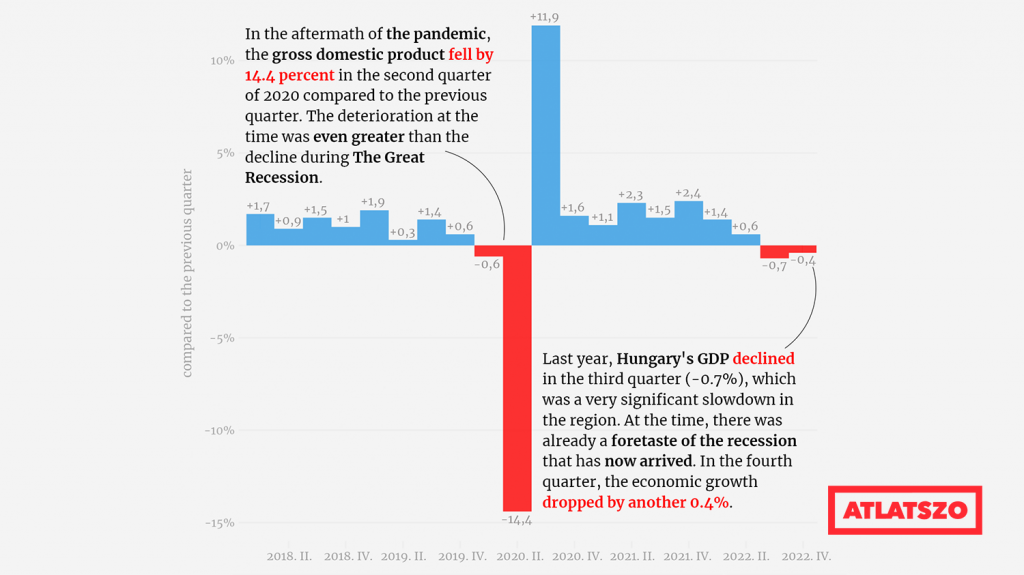The https://english.atlatszo.hu use cookies to track and profile customers such as action tags and pixel tracking on our website to assist our marketing. On our website we use technical, analytical, marketing and preference cookies. These are necessary for our site to work properly and to give us inforamation about how our site is used. See Cookies Policy
Hungarian economy slips into technical recession for the second time in three years
Hungary has officially entered a technical recession, according to the latest data from the Hungarian Central Statistical Office. Hungarian GDP has been in decline since the third quarter of 2022, and our economy slowed again by 0.4 percent compared to the previous quarter, says latest report. This fulfils typical conditions of a technical recession. Hungarian experts had predicted an economic downturn months ago.
Our gross domestic product has been in decline since the third quarter of 2022, with a 0.4 percent fall in GDP compared to the previous quarter, according to the Hungarian Central Statistical Office (KSH) last November. At that time, the pace of economic growth was basically slowing down worldwide, but within the region, Hungary’s quarterly GDP fell the most after Slovenia, tied with Croatia. This marked the start of the path towards recession.

Our analysis in February revealed that we are the only country in the EU where the GDP in euro has fallen by the third quarter compared to the first quarter of 2022, while all other countries have seen an increase. Hungary’s prime minister has been warning of a European recession because of the sanctions against Russia, but the figures showed that the threat of a recession was mostly true for the Hungarian economy. KSH’s explanation was that the weakening Hungarian forint is the reason for the unique fall of our GDP in euro.
Hungarian economic experts had already warned about a looming recession in the autumn last year. At the time, economist Péter Ákos Bod said that he considers another negative GDP index in the fourth quarter to be a possibility, which would fulfill the usual condition for entering a recession.
In an earlier interview with Átlátszó, Júlia Király, former vice-president of the Hungarian National Bank (MNB), said that an economic stagnation is more likely than a growth in 2023. The decline in output is mainly due to the energy crisis and the war, but on the production side, agriculture and drought have also played a very important role. At the time, the former MNB vice-president said that it was difficult to predict the extent of the downturn, but it was expected to be much lower than in 2009 or even 2020. Nevertheless, we are still going to feel it.
The projections were not wrong, with the fourth quarter GDP released by KSH on the 14th of February showing a decline once again compared to the previous quarter,
officially sending Hungary into technical recession again.
This is the second recession in the last three years. Between 2000 and 2022, four main quarterly economic downturns can be identified. During the global economic crisis, GDP started to fall in 2007 and reached its lowest point in 2009, when it dropped by 4.1 percent.
This was followed by a more significant slowdown in 2012, when both the first and second quarters turned negative. We were then the only country in the Eastern European bloc to react to the eurozone crisis with a downturn. While we did not experience a recession in 2016, we did experience a temporary setback in economic performance of 0.5 percentage.
The last time our quarterly GDP was heavily in negative territory was during the pandemic. In the second quarter of 2020, economic growth fell by as much as 14.4 percent compared to the previous quarter.
Hungary is in a particularly problematic situation
While the world economy faced a year of difficulties in 2022 for global reasons, the situation in Hungary is particularly dire due to misguided and ill-timed government decisions.
In an earlier interview, Julia Király said that the current economic situation is a natural consequence of the overstretched growth that occurred in the years preceding the pandemic. Since extra high interest rates are needed to stop inflation in Hungary, it is automatically a drag on growth. Király said that the moment inflation moderates and the budget is committed to debt reduction, the situation could turn around. “We simply shouldn’t push that ultra-fast growth; we shouldn’t try to overtake again in the corner”.
According to Portfolio‘s Hungarian analysis, the short-term outlook is not looking good yet, as the adjustment process to the crisis is still ongoing. „The first quarter of 2023 is likely to bring a downturn, but it cannot be ruled out that we might see a minimal improvement compared to the previous quarter. The recent drop in energy prices has done much to improve sentiment in Europe and if it continues, the economic climate could be much more favorable for the whole year than it was expected a few months ago” – Portfolio wrote.
Written and translated by Luca Pete. The original, Hungarian version of this story can be found here.


